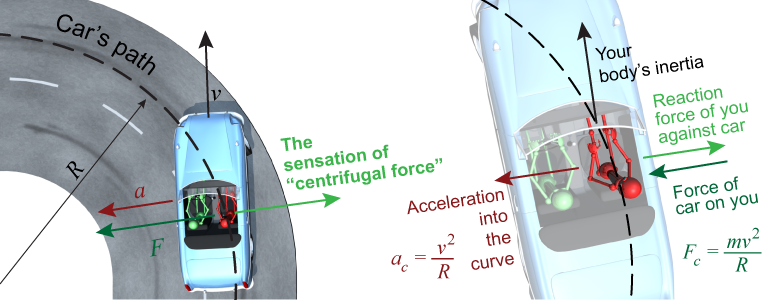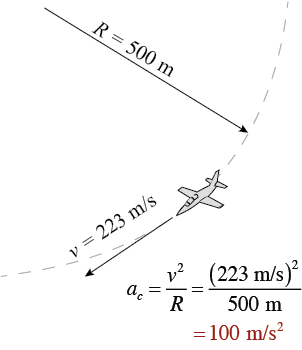|
Think about the last time you were in a car that drove around a corner quickly. You may have noticed a “force” pushing you toward the side of the car away from the corner. The faster the car rounds the corner, the stronger the perception of being “flung” outward. This effect is commonly known as centrifugal force. 
|

|
There is really not a force pushing you outward against the side of the car. What you feel is the structure of the car forcing your body to redirect its motion into a curve, rather than continuing in a straight line. The interior walls of the car exert a sideways force on you that points toward the center of the curve. The reaction force is your body pushing back against the side of the car. Although often called “centrifugal force,” this sensation of being pushed radially outward is actually a consequence of Newton’s first law (inertia) in a situation where your motion is being forced into a circle. 
|
 While centrifugal “force” is not a real force, centrifugal effects are found throughout nature and technology. For example, high-performance-aircraft pilots often push the limits of human endurance when they execute “high-g” maneuvers. A typical high-g maneuver is a tight radius turn at high speed. Consider a plane traveling at 223 m/s (500 mph) that makes a turn with a 500 m radius. A radius of 500 m means that the plane’s turn is 1 km across, which seems gradual. In reality, the centripetal acceleration is 100 m/s2! This is 10.2 times the acceleration of gravity (g = 9.8 m/s2) and this turn would be a “10.2g” maneuver if attempted.
While centrifugal “force” is not a real force, centrifugal effects are found throughout nature and technology. For example, high-performance-aircraft pilots often push the limits of human endurance when they execute “high-g” maneuvers. A typical high-g maneuver is a tight radius turn at high speed. Consider a plane traveling at 223 m/s (500 mph) that makes a turn with a 500 m radius. A radius of 500 m means that the plane’s turn is 1 km across, which seems gradual. In reality, the centripetal acceleration is 100 m/s2! This is 10.2 times the acceleration of gravity (g = 9.8 m/s2) and this turn would be a “10.2g” maneuver if attempted. 
|
At 1g, your body feels its normal weight. In a 10.2g turn, however, the force acting on the body of a 70 kg pilot is nearly 7,000 N or 1,600 lb. At this acceleration, the heart cannot pump blood to the brain and an actual human pilot would lose consciousness. 
|
| |
|

